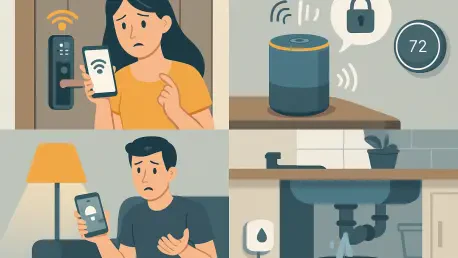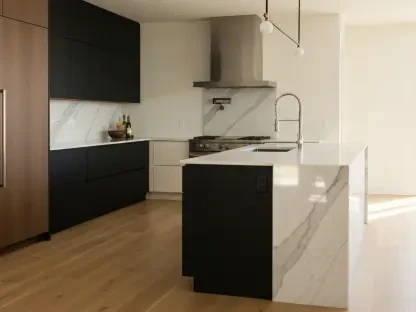Imagine a home where lights dim on command, doors lock with a tap on a smartphone, and a robot vacuum tidies up without lifting a finger—sounds like a dream, right? Yet, for many diving into the realm of smart home technology, this vision of effortless living can quickly turn into a frustrating maze of glitches, compatibility issues, and unexpected costs. A seasoned technology journalist with over two decades of experience shared invaluable lessons from personal missteps while setting up a smart home in an apartment setting. These errors, born from trial and error, reveal the hidden pitfalls that can derail even the most enthusiastic tech adopters. This article uncovers six critical mistakes made during the journey to automation, offering actionable insights to help anyone build a seamless and efficient smart home system. Whether just starting out or troubleshooting an existing setup, these lessons serve as a guide to dodge common blunders and achieve that futuristic home without the headaches.
Cutting Corners on Device Quality
Smart home technology often tempts buyers with budget-friendly options that promise big results for a small price. However, opting for the cheapest smart plugs or devices can lead to significant disappointment. For instance, a four-pack of plugs priced under $10 might seem like a steal, but unreliable connections and frequent failures often plague such purchases. In contrast, investing in higher-quality alternatives, typically around $30 per unit, ensures durability and consistent performance. The upfront cost may sting, but it pales compared to the frustration of replacing faulty gadgets or dealing with spotty functionality. This underscores a fundamental truth: quality matters more than initial savings when building a reliable smart home environment that stands the test of time.
Beyond the immediate annoyance of malfunctioning devices, skimping on quality can disrupt the entire smart home experience. A single unreliable smart plug can throw off automated routines, like turning on lights at dusk or powering a coffee maker in the morning. Such hiccups not only inconvenience daily life but also erode trust in the technology itself. Spending a bit more on reputable brands often guarantees better integration with other devices and platforms, reducing the likelihood of compatibility issues down the line. The lesson is clear—prioritizing well-made products from the start prevents a cascade of problems, saving both money and sanity in the long run while fostering a smoother, more dependable automated setup.
Navigating Network Configuration Challenges
Setting up smart devices often involves more than just plugging them in and downloading an app; network configurations play a crucial role in their success. Many smart gadgets are designed to connect exclusively to the 2.4GHz Wi-Fi band during initial setup, and failing to adjust a dual-band router to single-band mode temporarily can result in frustrating connectivity issues. This small oversight can halt the entire installation process, leaving devices offline and users puzzled. Understanding the specific requirements of each gadget and preparing the network accordingly is essential to avoid these early stumbling blocks that can sour the smart home journey before it even begins.
Equally problematic is neglecting to revert the network settings after setup is complete. Leaving a router in single-band mode might solve the initial connection problem for one device, but it often slows down internet speeds for other household tech reliant on the faster 5GHz band. This can lead to lagging video streams, delayed downloads, and overall dissatisfaction with the home network. The key takeaway is to remain vigilant about Wi-Fi settings throughout the setup process, ensuring that adjustments are temporary and reversed when no longer needed. A little extra attention to these technical details can prevent widespread connectivity woes, keeping the entire smart ecosystem running smoothly without sacrificing performance across devices.
Steering Clear of Subscription Snares
One of the more insidious traps in the smart home landscape involves security cameras and doorbells that lock essential features behind recurring subscription fees. Basic functionalities like video storage or accurate motion detection often require annual payments, which can add up quickly and turn an affordable device into a costly commitment. Without these paid plans, users might face incessant false alerts or limited access to footage, rendering the hardware far less useful. This financial burden can catch many off guard, transforming what seemed like a one-time purchase into an ongoing expense that strains the budget over time.
Fortunately, the market now offers alternatives that prioritize user-friendly economics. Newer devices with local storage options and free AI-driven features eliminate the need for monthly or yearly fees, providing the same level of security and convenience without the added cost. Researching these subscription-free options before committing to a purchase can save significant amounts in the long term while ensuring that smart security solutions remain effective. The emphasis here is on foresight—choosing products that deliver value without hidden strings attached allows for a more sustainable and satisfying smart home experience, free from the weight of unexpected financial obligations.
Embracing Timely Technology Upgrades
Holding onto outdated smart devices longer than necessary can turn convenience into a chore, as older models often lack the advancements that make modern tech truly transformative. For example, sticking with a basic robot vacuum that requires manual floor clearing and constant supervision wastes time and effort. Upgrading to a newer version with self-emptying bins, obstacle avoidance, and room mapping can revolutionize daily routines, turning a tedious task into an effortless background process. Recognizing when a device no longer meets current needs is vital to maintaining an efficient and frustration-free smart home setup.
Delaying these upgrades often stems from a reluctance to spend more or a belief that the existing tech is “good enough.” However, the rapid pace of innovation means that newer models frequently offer substantial improvements in performance and user experience. Investing in updated technology not only enhances functionality but also often integrates better with other smart systems, creating a more cohesive network. The insight here is to stay proactive—regularly assessing the performance of smart devices and replacing outdated ones ensures that the home automation system evolves alongside technological advancements, delivering maximum benefit with minimal hassle.
Committing to a Single Smart Ecosystem
Dabbling in multiple smart speaker platforms within the same household can create a chaotic environment where nothing works as intended. Mixing devices from different ecosystems often results in misdirected voice commands, clashing automation routines, and general confusion among household members. This fragmented approach undermines the very purpose of smart home tech, which is to simplify and streamline daily tasks. Selecting a single platform—whether it’s Amazon, Google, or Apple—and sticking to compatible devices is a crucial step toward achieving a harmonious and intuitive user experience.
The consequences of ecosystem mismatches extend beyond mere inconvenience; they can also hinder the scalability of a smart home setup. Adding new devices becomes a gamble when they don’t align with the primary system, potentially requiring additional hubs or workarounds that complicate maintenance. Consistency in choosing a unified platform ensures smoother updates, better support, and a more reliable network of interconnected gadgets. The advice is straightforward—commit to one ecosystem early on to build a foundation that supports seamless expansion and operation, avoiding the pitfalls of a disjointed technological mess.
Understanding the Depth of Technical Demands
Smart home technology, while marketed as user-friendly, often demands a level of technical know-how that many underestimate at the outset. The assumption that setup is as simple as plug-and-play frequently leads to unexpected hurdles, from configuring Wi-Fi bands to troubleshooting device interactions. These challenges can quickly overwhelm those unprepared for the learning curve, turning excitement into exasperation. Acknowledging that a successful smart home requires research, patience, and a willingness to tackle technical issues is the first step toward overcoming these barriers and achieving a functional system.
Moreover, the fragmented nature of the smart home industry—with its myriad brands, protocols, and standards—adds another layer of complexity. Compatibility isn’t guaranteed, and even small oversights can disrupt the entire network, whether it’s a mismatched device or an overlooked firmware update. Diving into forums, guides, and manufacturer resources can equip users with the knowledge needed to navigate this intricate landscape. The core message is to approach smart home adoption with realistic expectations, investing time in understanding the technology to prevent minor errors from snowballing into major disruptions that derail the automation dream.
Prioritizing Long-Term Smart Investments
A recurring theme in smart home mishaps is the failure to consider long-term value over short-term savings when selecting devices. Opting for cheaper gadgets or services with hidden costs, like subscription plans, often leads to higher expenses through replacements or added fees. Similarly, clinging to outdated technology can diminish efficiency and increase manual effort, negating the benefits of automation. Evaluating purchases based on durability, compatibility, and overall cost-effectiveness is essential to building a system that remains functional and economical over extended periods.
This focus on long-term planning also applies to anticipating future needs and technological trends. Choosing devices that support emerging standards or offer robust update policies ensures that a smart home doesn’t become obsolete too soon. Such foresight minimizes the need for frequent overhauls and fosters a setup that grows with advancements in the field. Reflecting on past errors, it’s evident that emphasizing reliability and forward-thinking choices paved the way for a more sustainable smart home. The final takeaway is to always weigh the enduring impact of each investment, ensuring that today’s decisions support tomorrow’s convenience without recurring frustrations or financial strain.









